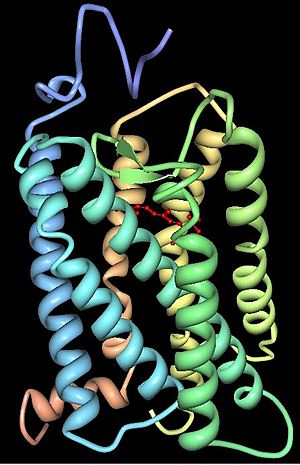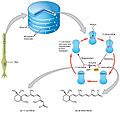Opsin facts for kids

Opsins are the universal photoreceptor molecules of all visual systems in the animal kingdom.
They change from a resting state to a signalling state by absorbing light. This activates the G protein, resulting in a signalling cascade which produces physiological responses.
This process of capturing a photon and transforming it into a physiological response is known as phototransduction.
Five groups of opsins are involved in vision. Another opsin found in the mammalian retina, melanopsin, is involved in circadian rhythms and pupillary reflex, but not in image-forming.
One opsin allows vision in just a short stretch of wavelength. This is equivalent to seeing in only one colour. Two opsins allow vision in two colours, and is usual in mammals. Four opsins allows vision in full colour, and is usual in teleost fish, reptiles and birds. In mammals, only Old World monkeys, apes and humans have full colour vision.
It is thought – see evolution of colour vision – that mammals lost much of their colour vision capability during the long period in the Mesozoic when they lived as mostly nocturnal animals.
- "...two cone opsin gene families appear in contemporary eutherian mammals and, with the exception of some primates, none of these animals derive more than a single photopigment type from each of their two gene families".
Images for kids
-
The retinal molecule inside an opsin protein absorbs a photon of light. Absorption of the photon causes retinal to change from its 11-cis-retinal isomer into its all-trans-retinal isomer. This change in shape of retinal pushes against the outer opsin protein to begin a signal cascade, which may eventually result in chemical signaling being sent to the brain as visual perception. The retinal is re-loaded by the body so that signaling can happen again.
See also
 In Spanish: Opsina para niños
In Spanish: Opsina para niños


